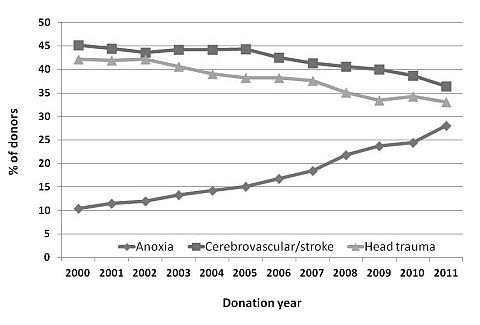Impact of Changing Patterns in Deceased Donor Cause of Death on Organs Transplanted Per Donor
United Network for Organ Sharing, Richmond, VA
Meeting: 2013 American Transplant Congress
Abstract number: C1404
Background: The distribution of donor cause of death (DCOD) has changed substantially over the last decade. This analysis was performed to assess geographic variability and the impact of DCOD on organs transplanted per donor (OTPD).
Data and Methods: All analyses are based on the OPTN database. The cohort includes all deceased donors recovered between 2000 and 2011.
Results: The three leading DCOD for deceased donors were anoxia, cerebrovascular/stroke, and head trauma, accounting for 98% of donors (18%, 42% and 38% for the 3 causes, respectively). The distribution of DCOD changed dramatically during this time.

Anoxic deaths for all deceased donors almost tripled between 2000 and 2011 from 10% to 28%. The % of deceased donors with anoxic deaths was much higher for DCD than in DBD (41% of DCD vs. 25% of DBD in 2011). The % of anoxia deaths varied considerably by UNOS Region: from 22% in Region 3 to 35% in Region 2 in 2011. Even more variability was seen across the 58 DSAs, ranging from 10% to 38% in 2011.
The average number of OTPD per year has remained fairly stable for DBD and DCD, overall and within DCOD. The range across years and the most recent value are shown, demonstrating fairly narrow ranges.
| OTPD range (OTPD in 2011) | ||
| DCOD | DBD | DCD |
| ALL | 3.1-3.3 (3.2) | 1.9-2.1 (2.0) |
| Anoxia | 2.8-3.0 (3.0) | 1.7-2.2 (2.1) |
| Cerebrovascular/stroke | 2.5-2.7 (2.7) | 1.6-1.8 (1.7) |
| Head trauma | 3.8-4.1 (4.0) | 2.2-2.5 (2.2) |
Among both DCD and DBD, donors with head trauma have the highest OTPD and those with cerebrovascular/stroke have the lowest.
If the OTPD in 2011 persists for the next 5 years for each DCOD and donor type combination, and the patterns of increase in anoxia and decrease in head trauma as DCOD continue, there may be a slight decrease in the overall OTPD for DBD (3.0) with no change seen for DBD (2.0).
Conclusion: Even with consistent OTPD within each donor type and DCOD combination, the overall OTPD may decline slightly in the future for DBD due to the changing distribution of DCOD.
To cite this abstract in AMA style:
Edwards L, Rosendale J. Impact of Changing Patterns in Deceased Donor Cause of Death on Organs Transplanted Per Donor [abstract]. Am J Transplant. 2013; 13 (suppl 5). https://atcmeetingabstracts.com/abstract/impact-of-changing-patterns-in-deceased-donor-cause-of-death-on-organs-transplanted-per-donor/. Accessed December 29, 2025.« Back to 2013 American Transplant Congress
